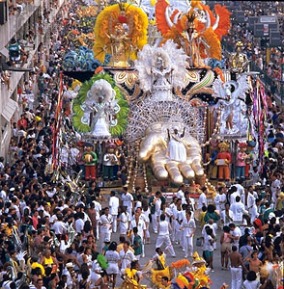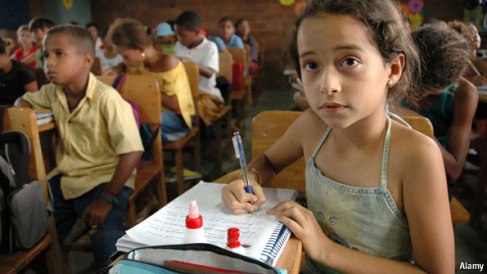Hanna Mincemoyer
Strong Performers and Successful Reformers
Introduction
Once students have completed their Fundamental Education they are allowed to enroll in secondary education, or ensino médio. Ensino médio loosely means middle education or middle school but corresponds to what we think of as high school. Occasionally grades 5-8 are considered “lower secondary” and are included in ensino médio, but they are actually ensino fundamental. The “upper secondary” education in Brazil is grades 9 to 11 and usually takes three years complete and requires a bare minimum of 2,200 hours of schooling. Students enter secondary education around age 15 and most complete it by the time they turn 17. The literacy rate for people age 15 to 17 is 84.1% as of 2006. Local and state governments are responsible for establishing education programs that follow the guidelines and use the funding supplied by the federal government. The state governments provide the public schools for secondary education so the schooling is free, but it is not mandatory.
The upper secondary education courses can be conducted either at the public or private school the child has been attending up until this point, or at specific colleges that prepare the students to take a specific entrance exam set by a specific university. In 1997, the public sector accounted for 85% of lower and upper secondary school enrollments with the private sector accounting for 15%. The private school enrollment for secondary education has remained fairly steady with 13% enrollment in 2009. The private sector participation increases as the students get older, accounting for about 20% of upper secondary enrollments and more than a third of all upper secondary education establishments. It is also possible to take professional training courses that last two years along with the regular Secondary Education track. These extra classes usually mean having more instructional hours per week and potentially taking a fourth year to complete.
History and Achievement
Until the year 1971, ensino médio had three different names: curso científico, curso normal and curso clássico. In 1971, it was united under the name segundo grau, which was eventually changed to ensino médio in 1996. The unification of these three names under the title of ensino médio helped to create a national standard for secondary education. At this time in Brazil the illiteracy rate was around 25%. It was clear that improvements needed to be made to the current education system and the overall education of the Brazilian population.
Between 1980 and 2000, in the 15 to 17 age demographic, the enrollment rate rose from 49.7% to 83%. While there have been significant advances in the past few years, it is very common for students to repeat grades and display poor academic achievement. The results of the national assessment test (SAEB) in 1997 reflected that only 52% of 8th graders and 26% of 11th graders were achieving at the expected level for their grade in Portuguese. One contributing factor to these academic problems was the high levels of absenteeism in Brazilian secondary schools. The graph below reflects a positive achievement trend for students who are just entering upper secondary school (students 15 years old). Many critics are demanding more progress, pointing out that the recent progress merely upgrades Brazil’s schools from disastrous to very bad. Backing up this assertion is the fact that two-thirds of 15 year olds are capable of no more than basic arithmetic.


Curriculum
The core curriculum for secondary education is made up of Portuguese, foreign language, history, geography, mathematics, physics, chemistry, biology, philosophy and sociology. The language education is delivered in is Portuguese, the official national language. During the military dictatorship between 1964 and 1985, philosophy and sociology were banned. They only recently became required classes again. The 1996 Education Law defines three objectives for secondary education: academic preparation, acquisition of tools for citizenship, and preparation for employment.
Unlike other countries, Brazilian students don’t have a final test to conclude studies. Their approval depends only on their final grade on each subject. Most universities create their own test to select and accept new students. One standardized test, the Vestibular, generally happens once a year and universities often evaluate these scores as well. Enem, a non-mandatory national exam, evaluates high school students in Brazil and is used to rank both private and public schools.
School Environment
Secondary education enrollments in Brazil amount to approximately 20 million students; 13 million in lower secondary and 7 million in upper secondary. Brazilian secondary school students are referenced by their year meaning they are called 1st, 2nd or 3rd year students. Often grades 5 to 11 are within one school building, blurring the distinction between early secondary and late secondary schooling. The educational year begins in February/March and finishes in December; institutions are permitted to define their own actual start and end dates. They must, however, provide at least 200 days of classes per year. The school year is generally divided into two semesters, the first from March through mid-July and the second from August through mid-December. Secondary schooling is sometimes provided during both the day and at night. The night school is very attractive for students enrolled in upper secondary education because they are able to hold a full time job at the same time. Around 60% of students enrolled in upper secondary school were enrolled in night school as of 2001.
The lack of funds and social problems Brazil is continually faced with contribute to poor attendance from the students, especially those in public schools. There is a large divide in resources available for students attending schools in wealthier areas versus schools in underprivileged areas. In 2001, 60% of the schools catering predominantly to wealthy students had computers while only 20% of the schools attended mostly by the poor were equipped with computers. This statistic reflects how the student make-up of a school can change the quality of education received.

